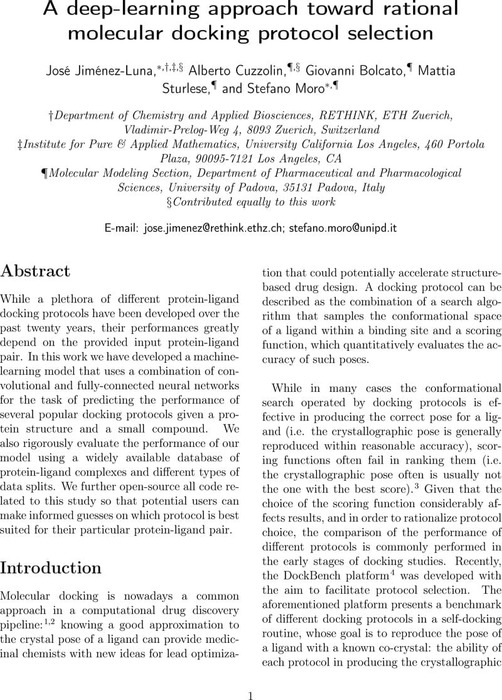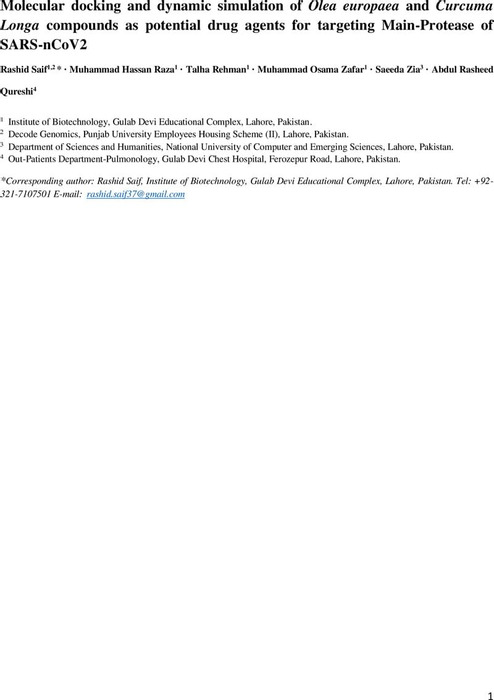

Each of these moves in the conformation space of the ligand induces a total energetic cost of the system. The moves incorporate rigid body transformations such as translations and rotations, as well as internal changes to the ligand's structure including torsion angle rotations. In this approach, the protein and the ligand are separated by some physical distance, and the ligand finds its position into the protein's active site after a certain number of “moves” in its conformational space. Simulating the docking process is much more complicated. They are also much more amenable to pharmacophore based approaches, since they use geometric descriptions of the ligands to find optimal binding. Shape complementarity methods can quickly scan through several thousand ligands in a matter of seconds and actually figure out whether they can bind at the protein's active site, and are usually scalable to even protein-protein interactions. Whereas the shape complementarity based approaches are typically fast and robust, they cannot usually model the movements or dynamic changes in the ligand/ protein conformations accurately, although recent developments allow these methods to investigate ligand flexibility. Yet another approach is to use a Fourier shape descriptor technique. Another approach is to describe the hydrophobic features of the protein using turns in the main-chain atoms. The complementarity between the two surfaces amounts to the shape matching description that may help finding the complementary pose of docking the target and the ligand molecules. In this case, the receptor's molecular surface is described in terms of its solvent-accessible surface area and the ligand's molecular surface is described in terms of its matching surface description. These features may include molecular surface / complementary surface descriptors. Geometric matching/ shape complementarity methods describe the protein and ligand as a set of features that make them dockable.

Both approaches have significant advantages as well as some limitations. The second approach simulates the actual docking process in which the ligand-protein pairwise interaction energies are calculated. One approach uses a matching technique that describes the protein and the ligand as complementary surfaces. Two approaches are particularly popular within the molecular docking community.
#MOLECULAR DOCKING PDF FREE#
It aims to achieve an optimized conformation for both the protein and ligand and relative orientation between protein and ligand such that the free energy of the overall system is minimized.

Molecular docking research focuses on computationally simulating the molecular recognition process. During the course of the docking process, the ligand and the protein adjust their conformation to achieve an overall "best-fit" and this kind of conformational adjustment resulting in the overall binding is referred to as "induced-fit". However, since both the ligand and the protein are flexible, a “hand-in-glove” analogy is more appropriate than “lock-and-key”. Molecular docking may be defined as an optimization problem, which would describe the “best-fit” orientation of a ligand that binds to a particular protein of interest. Here, the protein can be thought of as the “lock” and the ligand can be thought of as a “key”. This chapter discusses the background and theory of molecular docking software, and covers the usage of some of the most-cited docking software.One can think of molecular docking as a problem of “lock-and-key”, in which one wants to find the correct relative orientation of the “key” which will open up the “lock” (where on the surface of the lock is the key hole, which direction to turn the key after it is inserted, etc.). The setting up of the input structures for the docking is just as important as the docking itself, and analyzing the results of stochastic search methods can sometimes be unclear.

Docking can be used to perform virtual screening on large libraries of compounds, rank the results, and propose structural hypotheses of how the ligands inhibit the target, which is invaluable in lead optimization. Successful docking methods search high-dimensional spaces effectively and use a scoring function that correctly ranks candidate dockings. The goal of ligand-protein docking is to predict the predominant binding mode(s) of a ligand with a protein of known three-dimensional structure. Molecular docking is a key tool in structural molecular biology and computer-assisted drug design.


 0 kommentar(er)
0 kommentar(er)
